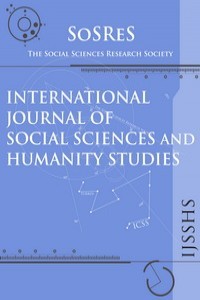AN APPLICATION OF ROLE IDENTITY THEORY TO FOSTER ACADEMICS CREATIVITY IN A RESEARCH UNIVERSITY
AN APPLICATION OF ROLE IDENTITY THEORY TO FOSTER ACADEMICS CREATIVITY IN A RESEARCH UNIVERSITY
Creative Role Identity, Creativity, Perceived Coworker Creativity Expectations, Self-Views Of Creative Behavior,
___
- Amabile, T. M., Conti, R., Coon, H., Hennesey, B. A., and Tighe, E. M. (1996), “Assessing the Work Environment for Creativity”, Academy of Management Journal. 39: pp.1154-1184.
- Aznizah N. K., (2004). Kajian Tentang Kreativiti Guru Sains dan Matematik Sekolah Menengah. Tesis Ijazah Sarjana Muda Sains serta Pendidikan (Kimia), Universiti Teknologi Malaysia, Skudai.
- Bandura, A. & Locke (2003),“Negative Self-Efficacy and Goal Effects Revisited”, Journal of Applied Psychology, 88(1), pp.87-99.
- Burke, P. J. (1991), “Identity processes and social stress”, American Sociological Review. 56: pp.836-849.
- Callero, P. L., Howard, J. A., and Piliavin, J. A. (1987), “Helping Behavior as Role Behavior: Disclosing Social Structure and History in the Analysis of Prosocial Action”, Social Psychology Quarterly. 50: pp.247-256.
- Farmer, S. M., Tierney, P. and McIntyre, K. K. (2003), “Employee Creativity in Taiwan: An Application of Role Identity Theory”, Academy of Management Journal. 46(5), pp.618-630.
- Goldsmith, R. E. and Matherly, T. A. (1987), “Adaptation, Innovation and Creativity: A Replication and Extension”, British Journal of Social Psychology. 26: pp.79-82.
- Kim, T.Y., Hon, A.H.Y., Lee, D.R. (2010), “Proactive Personality and Employee Creativity: The Effects of Job Creativity Requirement and Supervisor Support for Creativity”, Creativity Research Journal, 22(1), pp.37-45.
- Laupa Junus (2010, 27 Januari). MI 2010 Anjakan Inovasi Tempatan. Utusan Malaysia, http://www.utusan.com.my [Access on Mac 6, 2011]
- Mohd Azhar Abd. Hamid, Sanitah Mohd. Yusuf, Esa Khalid and Othman A. Kassim (2003), “Kreativiti, Invensyen dan Inovasi: Suatu Cadangan Matapelajaran pada Peringkat Sekolah Menengah. pp.71-83.
- Oldham, G. R. and Cummings, A. (1996), “Employee Creativity: Personal and Contextual Factors at Work”, Academy of Management Journal. 39(3), pp. 607- 634. Paper, D., Chang, R. & Rodger, J. A. (2000). The Role of Creativity in Business Improvement Paradigms: US versus Japanese Firms. Journal of Systems & Information Technology, 4(1), pp.8-22.
- Petrowski, M. J. (2000). Creativity Research: Implications for Teaching, Learning and Thinking. Reference Services Review. 28(4), 304-312.
- Sousa, C.M.P & Coelho, F. (2009). From Personal Values to Creativity: Evidence from Frontline Service Employees.
- Sternberg, R. J. and Lubart, T. I. (1999), “The Concept of Creativity: Prospects and Paradigms in Sternberg, R. J. (Ed.) Handbook of Creativity, Cambridge: Cambridge University Press. pp. 3-15.
- Wongtada, N. and Rice, G. (2008), “Multidimensional Latent Traits of Perceived Organizational Innovation: Differences between Thai and Egyptian Employees”, Asia Pacific Journal of Management.
- Başlangıç: 2009
- Yayıncı: Sosyal Bilimler Araştırmaları Derneği
ROLE OF SOCIAL FORESTRY IN SUSTAINABLE DEVELOPMENT - A MICRO LEVEL STUDY
ELT STUDENT TEACHERS’ COMPETENCE FOR TEACHING LANGUAGE SKILLS: A QUALITATIVE EXPLORATION
THE IMPACT OF COUNTRY-OF-ORIGIN EFFECT ON TURKISH CONSUMERS’ RESPONSE TOWARD FOREIGN ADVERTISEMENTS
AN APPLICATION OF ROLE IDENTITY THEORY TO FOSTER ACADEMICS CREATIVITY IN A RESEARCH UNIVERSITY
Roziana SHAARİ, Siti Fatimah BAHARİ, Nor Akmar NORDİN, Kamaruzzaman Abdul RAHİM, Azizah RAJAB, Mohd Hairil Faiz HANAFİAH
COMPARING MODERNIZATION IN IRAN AND TURKEY
Kolsoum Parhizkari, Steffen Kuehnel
“GREEN” CORPORATE SOCIAL RESPONSIBILITY: TO BE OR NOT TO BE?
Farrah Merlinda Muharam, Maria-Antonia Tarrazon
ALTERNATIVE DISPUTE RESOLUTION IN ISLAMIC FINANCE: RECENT DEVELOPMENT IN MALAYSIA
Jasri Jamal, Nor Aziah Mohd, Kamal Halili
INNOVATIONS AT ORGANISATION VIA CREATIVITY OF EMPLOYEES
